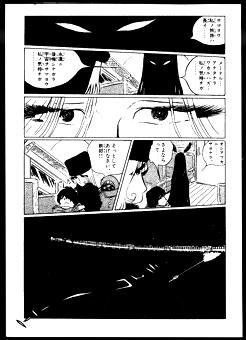Manga Manga!
The art of Japanese comic-strips

Leiji Matsumoto, Galaxy Express, 1999
With the exhibition Manga Manga! the Kunsthal introduces Dutch
museum visitors to a Japanese phenomenon. Immensely popular in
Japan. these comics have been available in Europe for some years
now in specialist shops. The Japanese are definitely the world's
most avid comic-strip consumers. Manga is a collective term for
comic magazines, newspaper strip cartoons and the bulky anthologies
of comics which often take up half the space in bookshops. Manga
accounts for almost 40% of Japanese magazine and book sales.
The popular weekly strip 'Shònen Jump' sells up to 4 million
copies. Newspaper kiosks are bursting with manga. and there are
even automatic vending machines for the real manga addicts. Manga
is big business. and there are thousands of cartoonists in Japan
to satisfy the vast demand. Many of them as rich and famous as
pop stars. Annual prizes are awarded: newspapers publish reviews
and serious appraisals. The kunsthal show presents a selection
of the prolific manga production from 1945 to the present. Most
of the 145 open books. accompanied by Dutch translations, contain
short manga stories and act as an introduction into the development.
dissemination and cultural background of the phenomenon. A Japanese
manga is rarely a slim book: a weekly comic is often as thick
as a telephone directory and contains short stories as well as
long-running series. Manga caters to the needs of every generation.
an English caption on the cover indicating the target-group,
for instance 'Lady's Comic'. 'Comic for Business Boys' or 'Exciting
Comic for Men'. The series are often subsequently published in
books whose thousands of pages fill several volumes.
Manga acquired its present form after World War Two as the result
of industrialisation and urbanisation in Japan and the rise of
mass culture. Manga is an important leisure activity in Japan's
collectively organised and highly disciplined society. Comics
are easier to read than a novel, they occupy less space than
a TV set and are not a disturbance to anyone else. The Japanese
are fast readers - it takes them 20 minutes on average to finish
a 320-page book. less than 4 seconds a page. It is hard to imagine
life without manga. which has penetrated TV programmes. computer
games. toys. contemporary art and history text-books.
Film tricks
Manga drawings are unambiguous. linear. black-and-white (colour
is rarely used) and virtually without shadow effects. The long
strips make copious use of visual inventions. Film techniques
are common and include perspectives involving the reader in the
action, close-ups. unusual angles. fade-in and fade-out. montage
and varying the number of frames to prolong a scene. Quite often
there are no text-balloons for several pages. images sufficing
to convey the story. In 'Kazure Okami' (Wolf and Child) a Samurai
classic. sword-fights can go on for 30 pages. the only 'sound'
being the clashing of steel. Abundant use is made of such 'sound-effects':
other examples are the impact of a fist on a chin ('POW! ') or
noodles being gobbled
('SURU SURU').
Over the years a variety of easy-to-understand conventions have
been established. The passing of time is indicated by a picture
of a rising or setting sun. a change of location by a telephone
pole or the facade of a building.
Buddha. money. sex and violence
There are manga for every target-group and on every conceivable
subject. Boys like a mix of excitement and humour. a preference
catered to by manga about sport. adventure. ghosts. science fiction.
school life and (smutty) jokes. For girls the emphasis is on
stories and idealised love: the stylised heroes and heroines
often have a western look. 'Shònen Manga' is the most
popular comic for boys. 'Shòjo Manga' for girls. The 350-page
weekly editions contain 15 stories. some of them complete. others
episodes from a series. The cover and first pages are in colour.
the rest in black-and-white.
Adult manga range from religion to adventure, from history to
pornography. Most are undemanding:
amusement is paramount. Wild scenes with violence. sex and obscenities
abound. The artists. often self-taught. have few literary ambitions.
Accordingly. many strips are ineptly designed and sheer trash.
There are however quite serious 'jitsuma manga' (practical comics)
and 'benkyo manga' (study strips) too, their themes ranging from
high school to international finance. A tendency towards more
intellectual manga can also be observed. Osamu Tezuka (1928-1989).
one of the best-known manga artists. drew the life of Buddha.
and Reiji Matsumoto (1938) made a successful manga about the
life of a poor student waiting to be admitted to university.
Ideograms
From a western point of view, the Japanese read the wrong way
round. i.e. from right to left. The texts are usually printed
vertically in the balloons and are read from top to bottom and
from right to left. There are four notation systems in Japanese;
used in combination. they can help create a special atmosphere.
For example. a Chinese personage might be given angular ideograms.
while a westerner's text might be written in the horizontal katakana
script reserved for borrowings from other languages.
Manga's success may well have something to do with the visual
script of the Japanese. The frequently used ideograms derive
from the Chinese, and were less abstract in the past. Manga also
has links with traditional Japanese art forms such as emakimono,
12th-century scrolls. and the popular books combining pictures
and text which were published from the 17th century on.
|